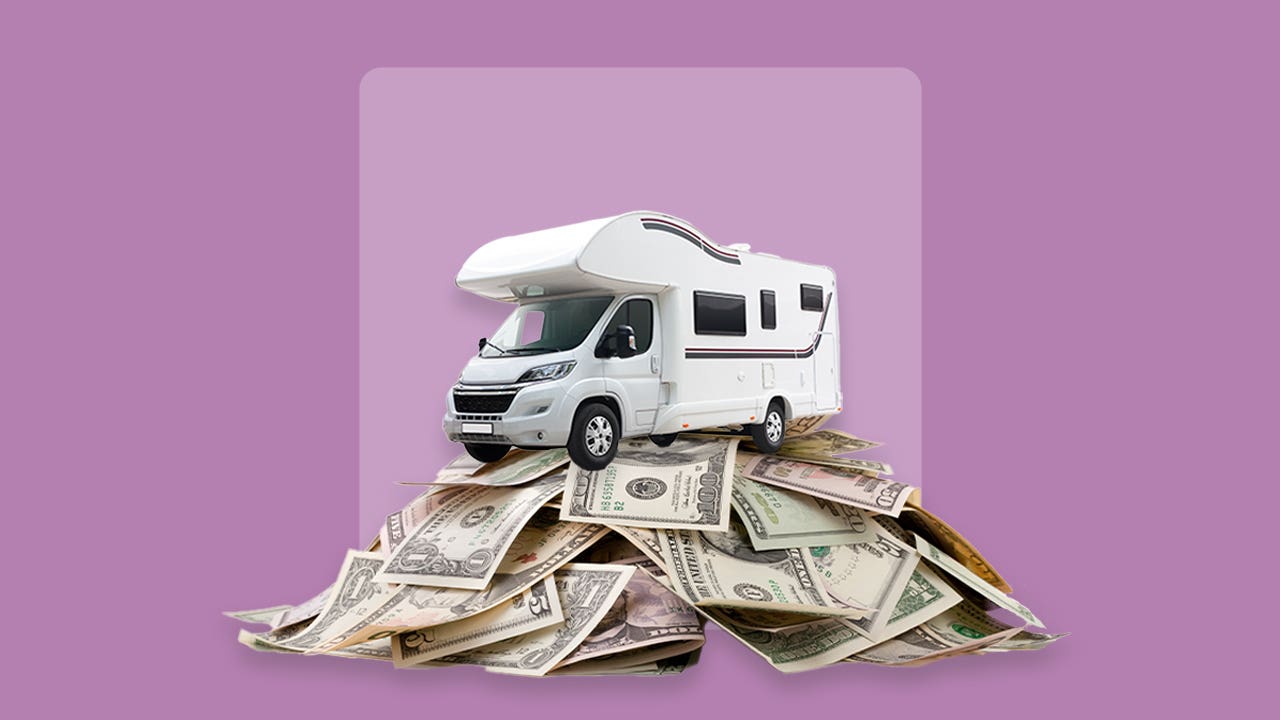How to get an RV loan without breaking the bank




Key takeaways
- You can get an RV loan from banks, credit unions, online lenders and at some RV-specific dealerships.
- Loan amounts for RVs can range from $10,000 to over $1 million, with terms of up to 20 years for secured loans and two to seven years for unsecured loans.
- To qualify for an RV loan, you’ll need to meet certain credit score, income and debt requirements, in addition to any lender-specific requirements.
- To boost your chances of approval, make sure your finances are in order and research lenders to find options that cater to your borrowing needs.
RV loans are a type of installment loan used to purchase a recreational vehicle. Once you qualify, your lender issues you a lump sum to purchase your RV, which you repay in equal monthly payments made up of the principal and interest charges.
RV prices are high, ranging from $10,000 to $1 million, so most buyers finance their purchase. Financing an RV can be as simple as buying a car or as complicated as applying for a mortgage, depending on the type of RV you purchase, its price and your intended use for it. Understanding how RV financing works will help you choose the best financing options for your situation.
What is an RV loan?
An RV loan is used to purchase an RV, camper or travel trailer. Most are secured loans, but you can also purchase an RV using an unsecured personal loan. Both secured and unsecured RV loans are usually installment loans, which means you receive all of your funds at once and make monthly payments based on the terms you’re approved for.
Starting APRs for unsecured RV loans are around 7 percent, but rates for borrowers with bad credit can reach 36 percent. Typical RV loan terms range from five to seven years, although secured loan terms can be much longer.
Secured loans
Most RV are financed with secured loans, where the vehicle you purchase acts as collateral that can be repossessed if you default on the debt. Lenders offering secured loans will determine your eligibility for an RV loan based on your credit score, income, total debt and the RV you are buying.
Secured loans typically come with lower rates and fees than unsecured loans, which can translate to lower monthly payments. And if you secure financing through the RV dealership, you may snag a promotional rate or special deal. However, lenders may place restrictions on which RVs you can purchase based on age, condition and value.

Pros
- Typically lower rates and fees than unsecured loans
- Higher loan amounts available
- Longer terms available, sometimes up to 20 years
- May be available through your dealership

Cons
- Lender could repossess your RV if you default
- Not all RVs are eligible for secured financing
- Longer approval process that may require a down payment
- Dealer perks and discounts may only be available through certain lenders
Unsecured RV loans
You can also use an unsecured personal loan to buy an RV. Since your RV doesn’t serve as collateral for the loan, you will qualify based on your credit, income and debt-to-income (DTI) ratio, not the vehicle you are purchasing.
You don’t have to choose your RV before getting approved for a personal loan, and you’re free to choose from used models if you prefer. Personal loan amounts typically start around $1,000, making them a good choice for purchasing less expensive RVs.
Keep in mind that unsecured loans usually have higher interest rates. This may be offset by a strong credit score, but bad credit loan rates can reach up to 36 percent, leading to exceptionally high monthly payments.

Pros
- No risk of losing your vehicle to repossession
- No limitations on the vehicle you choose
- Less documentation required for approval
- Quick funding turnaround

Cons
- Typically higher rates and fees than secured RV loans
- Terms are usually capped at seven years
- Lower maximum loan amounts
- May be difficult to qualify with bad credit

The best personal loan rates of 2025
If an unsecured loan is right for you, consider Bankrate's picks for the best personal loan lenders.
Learn moreSteps for financing an RV
The RV loan application process is similar to the process of applying for an auto loan. However, approval may be more difficult since lenders have stricter requirements for RV loans because of their large amounts.
Many RV dealerships offer on-site financing with special discounts or perks for using their in-house lender. However, you may find better rates for financing through a credit union or bank with which you already have an established relationship. Online lenders are another option, too.
1. Prequalify with multiple lenders
Once you’ve researched the best RV loan lenders and chosen those that align with your borrowing needs, use loan prequalification to gather quotes without hurting your credit score. This will decide how much you can spend and what your monthly payments will look like.
If you want to finance through a dealer, find one who works with multiple lenders to increase your chances of receiving a competitive offer. You may even ask the dealer to match or beat your prequalified offer.

The best RV loans of 2025
Review Bankrate's top picks for RV loans and get prequalified to find your best option.
Learn more2. Consider your loan amount
RVs are available at a wide range of prices. Towable pop-up campers start as low as $5,000, while luxury models can cost over $1 million. Buying a more expensive RV will mean borrowing more at a higher APR, so consider your needs and budget carefully.
New RVs will offer the latest features, but just like a new car, they face steep depreciation. Used RVs cost significantly less and may meet your needs just as well.
Don’t forget to factor in the cost of operating and traveling in your RV. If you decide that purchasing an RV is not the best choice financially, consider renting an RV instead.
| New | Used | |
|---|---|---|
| Class A | $50,000 to $300,000 | $30,000 to $175,000 |
| Class B | $70,000 to $150,000 | $40,000 to $115,000 |
| Class C | $50,000 to $150,000 | $30,000 to $75,000 |
| Travel trailer | $20,000 to $75,000 | $10,000 to $50,000 |
| Fifth wheel | $35,000 to $125,000 | $30,000 to $100,000 |
| Source: Camper FAQs |
3. Complete an application
On your application, you will need to provide personal information such as:
-
Your full name and date of birth
-
Your Social Security number
-
Employment information
-
Proof of identity and address
-
Proof of income, such as copies of recent tax returns, pay stubs or W-2s
4. Sign the loan agreement
Review your loan terms carefully, particularly your monthly payment amount and due date. Clarify any confusing parts of your loan agreement and sign your offer.
Some lenders offer next-day funding, while others may take up to two weeks. If you finance through a dealer, you may be able to finance and purchase your RV on the same day.
Getting approved for an RV loan: Factors to consider
The process of applying for an RV loan may be similar to applying for a car loan, but qualifying for an RV loan can be much harder because the high price of RVs makes them luxury items. Lenders will consider your credit score, credit history, income and interest rates.
Credit score
Most RV lenders require a FICO score of 670 or better to qualify for a loan. Some lenders approve borrowers with lower scores, but you’ll need a score in the mid-700s or higher to secure the lowest rates.
Check your credit reports with the three major credit bureaus — Experian, Equifax and TransUnion — before you begin applying for an RV loan. Disputing errors you find or taking steps to build your credit score can increase your chances of securing a lower rate. A free copy of your credit report from all three bureaus is available weekly from AnnualCreditReport.com.

How to check your credit score
Before you apply for an RV loan, check your credit score to ensure you'll qualify for a competitive rate.
Learn moreCredit history
Lenders will look for a history of on-time payments on credit cards and installment loans, such as student loans, personal loans or a mortgage. Late or missed payments and defaults hurt your chances of approval.
The longer your credit history, the more trustworthy you’ll appear to lenders — especially if that history includes responsible debt management.
Income
Your lender will ask you to provide proof of income and statements of debts to calculate your debt-to-income ratio (DTI). Your DTI shows how much of your monthly income goes to paying debts. Generally, lenders want to see a DTI under 36 percent to approve a borrower.
Use Bankrate’s personal loan calculator to determine how much you can reasonably afford to borrow.
Interest rates
RV loan rates start at just under 7 percent — but the best RV loan rates go to borrowers with high credit scores, often in or above the mid-700s. You may also get a slightly lower rate if you make a down payment of 10 to 20 percent.
Secured RV low rates are usually lower for new vehicles than used. For unsecured loans, your rate will be based on your credit score and could go as high as 36 percent if your score is low.
Lender-specific requirements
Every lender sets its own requirements for approval. While most will set a minimum credit score and income requirement, some may also ask how you plan to use your RV and whether it will be your primary residence. They may also consider the vehicle’s condition.
Check each lender’s requirements before applying to avoid unnecessary loan denials.
Bottom line
A secured RV loan is the least expensive way to finance a coach, camper or trailer, but an unsecured personal loan is also an option. Whichever type of financing you choose, consider your budget and current debt load carefully before committing to purchasing an RV.
You can increase your chances of approval for an RV loan by checking your credit score and income against lenders’ requirements before applying. And you can ensure you get the best terms for your situation by prequalifying with multiple lenders.
You may also like

How to get a personal loan with low interest rates

SBA 7(a) loan: What it is and how to apply

How to get a business loan with multiple owners

Semi-truck financing requirements
